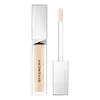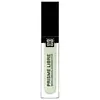What's inside
What's inside
 Key Ingredients
Key Ingredients

 Benefits
Benefits

 Concerns
Concerns

 Ingredients Side-by-side
Ingredients Side-by-side

Water
Skin ConditioningMethyl Trimethicone
Skin ConditioningPhenyl Trimethicone
Skin ConditioningIsododecane
EmollientDimethicone
EmollientAcrylates/Dimethicone Copolymer
Skin ConditioningButylene Glycol
HumectantGlycerin
HumectantCetyl PEG/PPG-10/1 Dimethicone
EmulsifyingTitanium Dioxide
Cosmetic ColorantHdi/Trimethylol Hexyllactone Crosspolymer
Silica
AbrasivePentylene Glycol
Skin ConditioningPhenoxyethanol
PreservativeDisteardimonium Hectorite
StabilisingGlyceryl Undecyl Dimethicone
Sodium Myristoyl Glutamate
CleansingCaprylyl Glycol
EmollientSodium Chloride
MaskingAluminum Hydroxide
EmollientPropylene Carbonate
SolventStearic Acid
CleansingHexadecene
SolventDipotassium Glycyrrhizate
HumectantPentaerythrityl Tetra-Di-T-Butyl Hydroxyhydrocinnamate
AntioxidantCI 77891
Cosmetic ColorantCI 77491
Cosmetic ColorantWater, Methyl Trimethicone, Phenyl Trimethicone, Isododecane, Dimethicone, Acrylates/Dimethicone Copolymer, Butylene Glycol, Glycerin, Cetyl PEG/PPG-10/1 Dimethicone, Titanium Dioxide, Hdi/Trimethylol Hexyllactone Crosspolymer, Silica, Pentylene Glycol, Phenoxyethanol, Disteardimonium Hectorite, Glyceryl Undecyl Dimethicone, Sodium Myristoyl Glutamate, Caprylyl Glycol, Sodium Chloride, Aluminum Hydroxide, Propylene Carbonate, Stearic Acid, Hexadecene, Dipotassium Glycyrrhizate, Pentaerythrityl Tetra-Di-T-Butyl Hydroxyhydrocinnamate, CI 77891, CI 77491
Water
Skin ConditioningC9-12 Alkane
SolventCaprylic/Capric Triglyceride
MaskingGlycerin
HumectantCI 77891
Cosmetic ColorantPropanediol
SolventCI 77163
Cosmetic ColorantCoco-Caprylate/Caprate
EmollientPentylene Glycol
Skin ConditioningStearalkonium Hectorite
Gel FormingTrimethylsiloxysilicate
EmollientPullulan
Sorbitan Sesquiisostearate
EmulsifyingSilica
AbrasivePolyglyceryl-3 Polyricinoleate
EmulsifyingPolyglyceryl-3 Diisostearate
EmulsifyingEthylene Brassylate
MaskingHydroxyacetophenone
AntioxidantSodium Chloride
MaskingCI 77288
Cosmetic ColorantSodium Benzoate
MaskingSynthetic Fluorphlogopite
Sodium Myristoyl Glutamate
CleansingTropaeolum Majus Flower/Leaf/Stem Extract
Skin ConditioningPolyhydroxystearic Acid
EmulsifyingCI 77492
Cosmetic ColorantPropylene Carbonate
SolventTocopherol
AntioxidantAluminum Hydroxide
EmollientCI 77491
Cosmetic ColorantIsostearic Acid
CleansingLecithin
EmollientTin Oxide
AbrasiveCitric Acid
BufferingWater, C9-12 Alkane, Caprylic/Capric Triglyceride, Glycerin, CI 77891, Propanediol, CI 77163, Coco-Caprylate/Caprate, Pentylene Glycol, Stearalkonium Hectorite, Trimethylsiloxysilicate, Pullulan, Sorbitan Sesquiisostearate, Silica, Polyglyceryl-3 Polyricinoleate, Polyglyceryl-3 Diisostearate, Ethylene Brassylate, Hydroxyacetophenone, Sodium Chloride, CI 77288, Sodium Benzoate, Synthetic Fluorphlogopite, Sodium Myristoyl Glutamate, Tropaeolum Majus Flower/Leaf/Stem Extract, Polyhydroxystearic Acid, CI 77492, Propylene Carbonate, Tocopherol, Aluminum Hydroxide, CI 77491, Isostearic Acid, Lecithin, Tin Oxide, Citric Acid
Ingredients Explained
These ingredients are found in both products.
Ingredients higher up in an ingredient list are typically present in a larger amount.
Aluminum Hydroxide is a form of aluminum. It can be naturally found in nature as the mineral gibbsite. In cosmetics, Aluminum Hydroxide is used as a colorant, pH adjuster, and absorbent.
As a colorant, Aluminum Hydroxide may add opacity, or reduce the transparency. Aluminum hydroxide is contains both basic and acidic properties.
According to manufacturers, this ingredient is an emollient and humectant. This means it helps hydrate the skin.
In medicine, this ingredient is used to help relieve heartburn and help heal ulcers.
There is currently no credible scientific evidence linking aluminum hydroxide in cosmetics to increased cancer risk.
Major health organizations allow the use of aluminum hydroxide in personal care products and have not flagged it as a carcinogenic risk at typical usage levels.
Learn more about Aluminum HydroxideCi 77491 is also hydrated iron III oxide. It's sole purpose is to give a red/pink hue to products.
Iron III oxides are classified as inorganic chemicals for coloring.
Synthetically created Ci 77491 is considered safer than those naturally found. This is because the synthetically created version may contain less impurities. Iron oxides are generally non-toxic and non-allergenic.
Learn more about CI 77491Ci 77891 is a white pigment from Titanium dioxide. It is naturally found in minerals such as rutile and ilmenite.
It's main function is to add a white color to cosmetics. It can also be mixed with other colors to create different shades.
Ci 77891 is commonly found in sunscreens due to its ability to block UV rays.
Learn more about CI 77891Glycerin is already naturally found in your skin. It helps moisturize and protect your skin.
A study from 2016 found glycerin to be more effective as a humectant than AHAs and hyaluronic acid.
As a humectant, it helps the skin stay hydrated by pulling moisture to your skin. The low molecular weight of glycerin allows it to pull moisture into the deeper layers of your skin.
Hydrated skin improves your skin barrier; Your skin barrier helps protect against irritants and bacteria.
Glycerin has also been found to have antimicrobial and antiviral properties. Due to these properties, glycerin is often used in wound and burn treatments.
In cosmetics, glycerin is usually derived from plants such as soybean or palm. However, it can also be sourced from animals, such as tallow or animal fat.
This ingredient is organic, colorless, odorless, and non-toxic.
Glycerin is the name for this ingredient in American English. British English uses Glycerol/Glycerine.
Learn more about GlycerinPentylene glycol is typically used within a product to thicken it. It also adds a smooth, soft, and moisturizing feel to the product. It is naturally found in plants such as sugar beets.
The hydrophilic trait of Pentylene Glycol makes it a humectant. As a humectant, Pentylene Glycol helps draw moisture from the air to your skin. This can help keep your skin hydrated.
This property also makes Pentylene Glycol a great texture enhancer. It can also help thicken or stabilize a product.
Pentylene Glycol also acts as a mild preservative and helps to keep a product microbe-free.
Some people may experience mild eye and skin irritation from Pentylene Glycol. We always recommend speaking with a professional about using this ingredient in your routine.
Pentylene Glycol has a low molecular weight and is part of the 1,2-glycol family.
Learn more about Pentylene GlycolThis ingredient is a solvent. It helps dissolve active ingredients and alter the texture of products.
Propylene Carbonate is commonly used in makeup and with clay, such as montmorillonite or bentonite.
Studies show this ingredient to be safe for cosmetics. When it is undiluted, it can cause skin irritation. (It is always diluted in skincare and makeup). This ingredient is water-soluble.
Propylene Carbonate is created from propylene glycol and carbonic acid.
Learn more about Propylene CarbonateSilica, also known as silicon dioxide, is a naturally occurring mineral. It is used as a fine, spherical, and porous powder in cosmetics.
Though it has exfoliant properties, the function of silica varies depending on the product.
The unique structure of silica enhances the spreadability and adds smoothness, making it a great texture enhancer.
It is also used as an active carrier, emulsifier, and mattifier due to its ability to absorb excess oil.
In some products, tiny microneedles called spicules are made from silica or hydrolyzed sponge. When you rub them in, they lightly polish away dead skin layers and enhance the penetration of active ingredients.
Learn more about SilicaChances are, you eat sodium chloride every day. Sodium Chloride is also known as table salt.
This ingredient has many purposes in skincare: thickener, emulsifier, and exfoliator.
You'll most likely find this ingredient in cleansers where it is used to create a gel-like texture. As an emulsifier, it also prevents ingredients from separating.
There is much debate on whether this ingredient is comedogenic. The short answer - comedogenic ratings don't tell the whole story. Learn more about comegodenic ratings here.
The concensus about this ingredient causing acne seems to be divided. Research is needed to understand if this ingredient does cause acne.
Scrubs may use salt as the primary exfoliating ingredient.
Learn more about Sodium ChlorideWe don't have a description for Sodium Myristoyl Glutamate yet.
Water. It's the most common cosmetic ingredient of all. You'll usually see it at the top of ingredient lists, meaning that it makes up the largest part of the product.
So why is it so popular? Water most often acts as a solvent - this means that it helps dissolve other ingredients into the formulation.
You'll also recognize water as that liquid we all need to stay alive. If you see this, drink a glass of water. Stay hydrated!
Learn more about Water